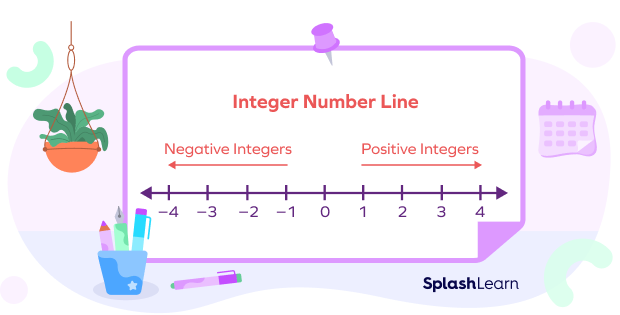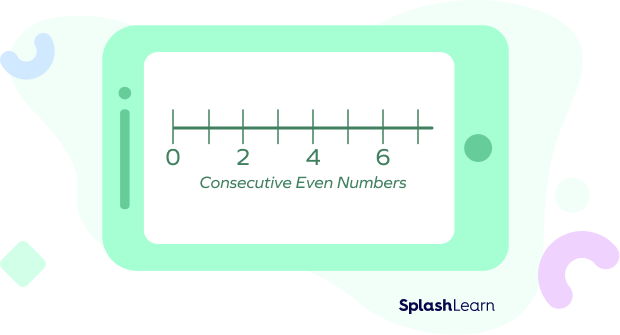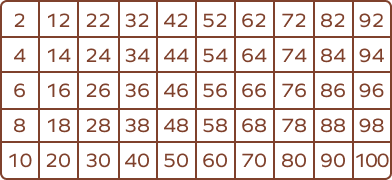What Are Consecutive Numbers?
The word “consecutive” simply means “following each other in a sequence, one after another.”
So, what is the meaning of consecutive numbers in math? The consecutive numbers are the numbers that follow each other without any interruption.
Consecutive numbers example: 1, 2, 3, 4, 5
Let’s consider an example in daily life. When we go to watch a movie with family or friends, we always try to get consecutive seats as we wish to sit together. So, we prefer seats that follow each other!
Consecutive Numbers Definition
Consecutive numbers are the numbers that continuously follow each other, one after another in a regular counting order or in the order from smallest to largest.
Consider the natural numbers. The numbers 1, 2, 3, 4,… are consecutive numbers.
The formula for consecutive numbers (assuming that the numbers follow each other by the difference of 1) can be written as $x,\; x+1,\; x + 2,\; x + 3$, …, and so on. We will discuss the formulas for more specific consecutive numbers in the coming sections.
 Begin here
Begin here
Successor and Predecessor
The concept of successor and predecessor helps in explaining the consecutive numbers more. Consider natural numbers for example.
Natural numbers = 1, 2, 3, 4, 5, 6,…
In this sequence, the difference between any predecessor-successor pair is 1.
- Predecessor of a number is the number which comes immediately before the number.
- The successor of a number is the number that comes immdiately after it.
So, we can say, the consecutive numbers follow the following pattern:
Predecessor, Number, Successor
Related Worksheets
Consecutive Integers
Integers positive integers, negative integers, and 0.
For example: $\;–\; 20,\; – \;8, 0, 2, 100$ etc.
So, the consecutive integers are the integers that continuously follow each other from smallest to greatest.
Let us take an example: $\;–\; 5, \;–\; 4, \;–\; 3, \;–\; 2, \;–\; 1, 0, 1, 2, 3, 4, 5$
Now if we see the difference between the predecessor and successor here, we get 1. For example: $\;–\; 1 \;–\; ( \;–\; 2) = \;–\; 1 + 2 = 1$
Consecutive Integers Formula
Integers follow each other in a sequence. The difference between two consecutive integers is always equal to 1.
For any given integer n, the formula to get a consecutive integer is $n+1$, where “n” can be any integer.

Thus, the sum of two consecutive integers n and $(n + 1)$ can be written as
$n + (n + 1) = 2n + 1$
Consecutive Even Integers
Even integers are the integers that are divisible by 2.
For example: $12, 4, 66, 518, 20, \;–\; 2, 2, \;–\; 4, 6, \;–\; 18, 20$ etc.
Let us consider an example of even integers from $\;–\; 2$ to 10.
We get $\;–\; 2, 0, 2, 4, 6, 8, 10$
We see that the difference between the predecessor-successor pair is 2.
Starting from an even number, if the difference between the predecessor-successor pair is 2, we get consecutive even numbers.

If n is an even number, consecutive even numbers form the following pattern:
$n, n + 2, n + 4$

Consecutive Even Integers Formula
The formula to find the consecutive even integer is 2n, where “n” can be any integer.
$2n, 2n+2, 2n+4, 2n+6,…$
Consecutive Odd Integers
Odd integers are the integers that are not divisible by 2.
For example: $–\; 1, 3, \;–\; 9, 11, \;–\; 43$ etc
Let us consider an example of odd integers from $\;–\; 11$ to 0.
We get $\;–\; 11, \;–\; 9, \;–\; 7, \;–\; 5, \;–\; 3, \;–\; 1$.
We see that we started from an odd number with the difference between the predecessor-successor pair being 2.
Such numbers form consecutive odd numbers.
If n is an odd integer, then $n + 2, n + 4$, and $n + 6$ are consecutive odd integers.

Consecutive Odd Integers Formula
The general formula to get a consecutive odd integer is $2n + 1$, where “n” can be any integer.
$2n + 1, 2n + 3, 2n + 5, 2n + 7,…$
Properties of Consecutive Numbers
- The difference between any predecessor-successor pair for consecutive numbers is always fixed. It can be 1 or more than 1.
- For any two consecutive even numbers, the difference is always 2.
For example, 8 and 10 are two consecutive odd numbers, their difference $= 10 \;–\; 8 = 2$.
- For any two consecutive odd numbers, the difference is also 2.
For example, 16 and 18 are two consecutive even numbers, their difference $= 18 \;–\; 16 = 2$.
- If “n” is an odd number, then the sum of “n” consecutive numbers will be divisible by “n.” For example, the sum of these 3 consecutive numbers is $2 + 3 + 4 = 9$ which is divisible by 3.
- The product of any three consecutive integers, is always divisible by 6.
$2 \times 3 \times 4 = 24$
$8 \times 9 \times 10 = 720$
How to Find the Consecutive Numbers When the Sum Is Given?
We can find the consecutive numbers when the sum is given.
Let us suppose the sum of two consecutive numbers is 75.
So, we know that two consecutive numbers are of the form $n,\;n + 1$
Sum $= 75$
$n + n + 1 = 75$
$2n = 74 \Rightarrow n = 37$
$n + 1 = 37 + 1 = 38$
So, the consecutive numbers whose sum is 75 is 37 and 38.
How to Find the Consecutive Numbers When the Product Is Given?
We can find the consecutive numbers when the product is given.
Let us suppose the product of two consecutive numbers is 30.
We will find the two perfect squares between which the product lies. Keep in mind that the perfect squares should belong to consecutive numbers.
We know that $5 \times 5 = 25$ and $6 \times 6 = 36$. So, the consecutive numbers whose product is 30 are 5 and 6.
Conclusion
In this article, we learned about consecutive numbers. Consecutive numbers are the numbers that follow each other. Let us now look at some examples to better understand the concept.
Solved Examples On Consecutive Numbers
1. Find the missing number in the series: 3, 4, 5, __, 7, 8, 9, 10
Solution:
The missing number is the predecessor of 7 and successor of 5.
These are consecutive natural numbers.
Thus, missing number $= 7 \;–\; 1 = 6 = 5 + 1$
So, the missing number is 6.
2. The sum of two consecutive numbers is 55. What are the numbers?
Solution:
The consecutive numbers are of the form: $n,\;n+1$
$n + n + 1 = 55$
$2n + 1 = 55$
$\Rightarrow 2n = 54$
$\Rightarrow n = 27$
The numbers are $27, 27 + 1$, i.e., $27$ and $28$.
3. Find the missing number in the series: 10, 14, 18, 22, ___, 26, 28.
Solution:
$10 + 4 = 14, 14 + 4 = 18, 18 + 4 = 22$.
So, the missing number in the series is: 22 + 4 = 26.
4. Find the missing integers in the series: – 8, __, – 4, – 2, 0, 2, __, 6, 8
Solution:
All the integers are divisible by 2.
So, it forms the consecutive even integers.
The missing integers will be – 6 and 4.
5. The product of two consecutive numbers is 156. Find the consecutive numbers.
Solution:
Choose consecutive numbers such that 156 lies between the squares of these numbers.
We know that $12 \times 12 = 144$ and $13 \times 13 = 169$
Here, $12 \times 13 = 156$.
Therefore, the numbers are 11 and 13.
Practice Problems On Consecutive Numbers
Consecutive Numbers: Definition, Formula, Properties, Examples
The sum of three consecutive numbers is 72. What will be the greatest number?
Let the three consecutive numbers be $n,\;n + 1$ and $n + 2$ respectively.
$n + n + 1 + n + 2 = 72$
$3n = 69 \Rightarrow n = 23$
So, the three consecutive numbers are 23, 24 and 25. The greatest of them is 25.
The sum of two consecutive odd integers is always ___.
The sum of two consecutive odd integers is always even.
Example: $3 + 5 = 8$
What are the two consecutive numbers if their product is 462?
The two perfect squares of consecutive numbers between which 462 lie is: 441 and 484, i.e., $21^2$ and $22^2$. Also, $21 \times 22 = 462$. So, the consecutive numbers are 21 and 22.
How many consecutive odd integers are there between – 10 and 10?
The consecutive odd integers between $– 10$ and 10 are $\;–\; 8, \;–\; 6, \;–\; 4, \;–\; 2, 0, 2, 4, 6, 8.$
Number $= 9$
The sum of two consecutive even numbers is 38. Find the numbers.
Let the two consecutive even numbers be 2n and $2n + 2$.
$2n + 2n + 2 = 38$
$4n = 38 \;-\; 2$
$4n = 36 \Rightarrow n = 9$
The consecutive even numbers are $2 \times 9$ and $2 \times 9 + 2$, i.e., 18 and 20.
Frequently Asked Questions On Consecutive Numbers
Is the sum of two even consecutive numbers always even?
Yes, the sum of two even consecutive numbers is always even.
For example: $24 + 26 = 50$ which is an even number.
Can consecutive numbers be decimals?
No, decimals can not be consecutive numbers as between two decimals there are infinitely many decimals.
Can consecutive numbers be fractions?
No, fractions can not be consecutive numbers as between two fractions there are infinitely many fractions.
What are non-consecutive integers?
Non-consecutive integers are simply the integers that are not written in order.
Example: 3, 7, 4, 2, 9





















